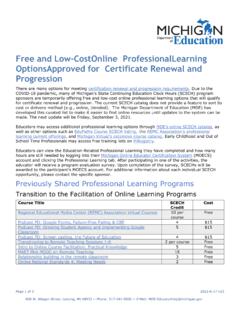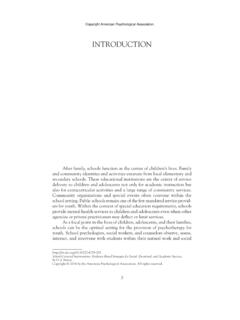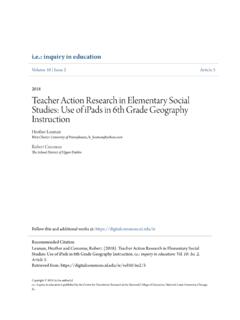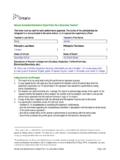Transcription of What Are Learning Objectives?
1 What Are Learning Objectives? A Learning objective should describe what students should know or be able to do at the end of the course that they couldn't do before. The lesson Objectives 1. The objectives must be clear to students. They ALL must know WHAT they are Learning and WHY they are doing it. They also need to see the point of the objectives in the bigger picture; that is, how they relate to the last lesson s Learning , the course they are following and the big overall goal.
2 This means that you can t simply write the objectives on the board and hope that the students copy them down. It implies that you have fully explained them in context; the students have engaged with them and can explain them to any observer. 2. The objectives and outcomes must be differentiated for the individual student. All the learners should be able to see where they are and what they need to do to get to the next level. This should link into subject standards and progression where possible.
3 It is crucial to have high expectations of what can be achieved and engage the students with that belief. 3. SUCCESS CRITERIA for achieving the outcomes need to be negotiated with the students for optimum engagement to enable them to be clear about what it will look like and feel like and sound like when they have made that progress. Example from an English Functional Skills lesson OBJECTIVE: To recognise the power of different types of language OUTCOMES: I will be able to: Use formal and informal language (Entry level) Explain how to speak and write in appropriate language (Level 1) Teach others how to use a range of writing and speaking styles appropriate for different audiences (Level 2) The Theory behind the teaching: Blooms Taxonomy What is a Learning Objective?
4 Whys should we use Learning objectives? Learning objectives should be brief, clear, specific statements of what learners will be able to do at the end of a lesson as a result of the activities, teaching and Learning that has taken place. They are sometimes called Learning outcomes. The Learning objective or objectives that you use can be based on three areas of Learning : knowledge, skills and attitudes. Learning objectives define Learning outcomes and focus teaching. They help to clarify, organize and prioritize Learning .
5 They help you and your students evaluate progress and encourage them to take responsibility for their Learning . What is the difference between an aim and a Learning objective? A lesson aim is a very general statement of what the overall goal is in a lesson the intention behind the teaching. The lesson objective/objectives are the measurable stages that a learner will go through and need to achieve in order to achieve the overall goal. Aims are like strategy, objective are like tactics How do you write aims and Learning objectives?
6 As part of your planning you need to decide what your students need to be able to DO after they have learned something that you have taught. Beginning your planning with the Learning objectives will also help you ensure that your tasks and activities are appropriate and will help your students achieve their objectives. A Learning objective must not include the phrases 'to know' or 'to understand' but instead active verbs such as 'state', 'explain', 'outline', 'list' or 'describe'.
7 Avoid using verbs that are difficult to measure objectively. The following verbs are difficult to assess and measure and therefore should be used with caution: Know, comprehend, understand, appreciate, familiarize, study, be aware, become acquainted with, gain knowledge of, cover, learn, realize Know and understand do not specify any overt 'doing' and although knowing and understanding underpin Learning , objectives are always written using active doing verbs. They are statements of what you want your learners to do and should Be stated clearly define or describe an action Are *measurable, in terms of time, space, amount, and/or frequency.
8 Be differentiated Examples of Measurable Action Words (examples) Explain Demonstrate Analyze Formulate Discuss Compare Differentiate Describe Name Assess Evaluate Identify Design Define List How can I differentiate my Learning objectives and make them more demanding and make sure that they are challenging? You can make your Learning objectives difficult, demanding or challenging by changing the active verb that you use (see detailed table below) to a more complex, involve higher order thinking; or you can add specific conditions or limits.
9 Putting the theory into practise The following lists and tables contain examples of active verbs which describe the sorts of things you want your students to be able to do and may help you to write useful Learning objectives. Set 1: Based on the 3 areas of teaching Knowledge analyse arrange calculate circle cite classify compare contrast compare define describe diagram differentiate group identify interpret itemize label list match name outline plan record revise select solve state tabulate give examples evaluate recognise Skills adjust assemble chart collect use draw employ establish illustrate imitate interact locate maintain measure modify operate organise rearrange return set up practice manipulate master fit perform
10 Demonstrate Attitudes accept adopt advocate approve assess challenge characterise choose criticise defend evaluate formulate judge justify manage model persuade recommend resolve select specify value re-assure empathise Set 2: Based on increasing level of difficulty and challenge (Blooms Taxonomy) Emphasis link to Blooms Taxonomy Relevant Action Verbs to use in your lesson objectives: Knowledge To find or remember information memorizing information Tell, uncover, show, state, define, name, write, recall, recognise, list, label, reproduce, identify, acquire, distinguish, state, order, locate, repeat, count, describe, enumerate, find, match, read, recite, record, select, sequence, state, view Comprehension To understand the information and restate in your own words, paraphrasing, summarizing, translating Comprehend, appreciate, select, indicate, illustrate, represent.





